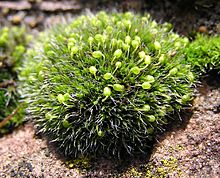Cryptogam: Difference between revisions
GrouchoBot (talk | contribs) m r2.7.2) (Robot: Adding ka:სპოროვანი მცენარეები |
|||
| Line 27: | Line 27: | ||
[[fa:نهانزادان]] |
[[fa:نهانزادان]] |
||
[[fr:Cryptogame]] |
[[fr:Cryptogame]] |
||
[[hi:क्रिप्टोगैम]] |
|||
[[it:Cryptogamae]] |
[[it:Cryptogamae]] |
||
[[he:חסרי זרע]] |
[[he:חסרי זרע]] |
||
Revision as of 08:05, 26 August 2012




A cryptogam (scientific name Cryptogamae) is a plant (in the wide sense of the word) that reproduces by spores. "Cryptogamae" (Greek κρυπτός kryptos, "hidden" + γαμέω, gameein, "to marry") means hidden reproduction, referring to the fact that no seed is produced, thus cryptogams represent the non-seed bearing plants. Other names, such as "thallophytes", "lower plants", and "spore plants" are also occasionally used. As a group, Cryptogamae are the opposite of the Phanerogamae (Greek φανερός, phaneros = "visible") or Spermatophyta (Greek σπέρμα, sperma = "seed" and φυτόν, phyton = "plant"), the seed plants. The best known groups of cryptogams are algae, lichens, mosses and ferns.[1] The classification is now deprecated in Linnaean taxonomy.
At one time, the cryptogams were formally recognised as a group within the plant kingdom. In his system for classification of all known plants and animals, Carl Linnaeus (1707–1778) divided the plant kingdom into 25 classes,[2][3] one of which was the "Cryptogamia". This included all plants with concealed reproductive organs. He divided Cryptogamia into four orders: Algae, Musci (bryophytes), Filices (ferns), and Fungi.[2]
Currently, not all cryptogams are treated as part of the plant kingdom; the fungi, in particular, are regarded as a separate kingdom, more closely related to animals than plants, while some algae are now regarded as allied with the bacteria. Therefore, in contemporary plant systematics, "Cryptogamae" is not a name of a scientifically coherent group, but is cladistically polyphyletic. However, all organisms known as cryptogams belong to the field traditionally studied by botanists and the names of all cryptogams are regulated by the International Code of Nomenclature for algae, fungi, and plants.
See Also
Plant, to see how cryptogams are distributed across modern classification systems
References
- ^ "Cryptogams". Royal Botanic Garden, Edinburgh. Archived from the original on 2007-11-18. Retrieved 2007-07-02.
- ^ a b G. M. Smith (1955). Cryptogamic Botany (PDF). McGraw-Hill, New York.
- ^ P. S. Dixon (1973). Biology of the Rhodophyta. Oliver and Boyd, Edinburgh. ISBN 0-05-002485-X.
